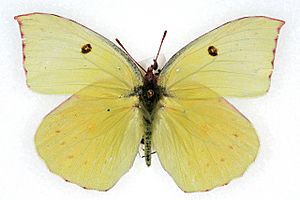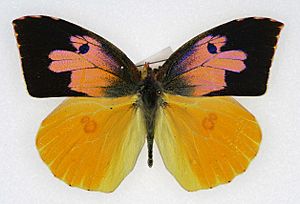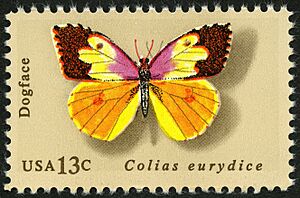California dogface butterfly facts for kids
Quick facts for kids California dogface butterfly |
|
|---|---|
 |
|
| Female | |
 |
|
| Male | |
| Conservation status | |
| Scientific classification | |
| Synonyms | |
|
Colias eurydice Boisduval, 1855 |
The California dogface butterfly, known scientifically as Zerene eurydice, is a special insect. It's part of the Pieridae family, which includes many yellow and white butterflies. This butterfly is very closely related to another group called Colias butterflies. Both Zerene eurydice and Colias butterflies often have cool yellow-orange and black patterns on their wings.
Male butterflies from both groups also have bright patterns on their wings that you can only see with UV light! There are only two types of Zerene butterflies: the California dogface and the Zerene cesonia, also called the Southern dogface. The California dogface butterfly is unique because it's only found in California. It's even California's official state insect!
Contents
What Does the California Dogface Butterfly Look Like?
The California dogface butterfly gets its name from the shape of its wings, especially the males. If you look closely at the male's wings, you might see a pattern that looks a bit like a dog's head!
Female California dogface butterflies are mostly yellow. They have two small black dots or dashes on each of their front wings. The males are different. Their front wings have black edges, which usually surround a bright yellow-orange area. They also have two black dots. Male butterflies have a special shiny color on their top front wings. This shimmer comes from tiny structures on their wings that reflect light. Scientists think this shiny look helps them find a mate.
These butterflies are quite big! Their wings can spread out to about 5.1 to 6.3 centimeters (2 to 2.5 inches) wide. Their wings are covered in tiny scales, which help them fly smoothly and stay warm. Their bodies also have tiny hairs that help them feel vibrations and touch.
Where Do California Dogface Butterflies Live and What Do They Eat?
You can only find the Zerene eurydice butterfly in California. They are often seen in the San Bernardino Mountains and Santa Ana Mountains in Southern California. Their favorite places to live are in the foothills, areas with chaparral plants, and in oak or coniferous woodlands. These areas usually have a mild climate.
When they are young, as larvae (caterpillars), these butterflies eat only two specific plants: Amorpha californica and Amorpha fruticosa. These plants are part of the Fabaceae family, which includes peas and beans. You can often find these host plants near poison oak, willow trees, and along streambanks. Young caterpillars and pupae (the stage before becoming a butterfly) are greenish-yellow. This color helps them blend in perfectly with their food plants, hiding them from hungry predators.
Adult California dogface butterflies are very fast flyers! It's hard to get close to them unless they are drinking nectar from flowers. Their speedy flight helps them escape from many different predators. These include ants, spiders, wasps, parasitic wasps, parasitic flys, birds, rats, toads, lizards, praying mantises, and snakes.
Adult butterflies love areas with moist soil. They drink nectar from many kinds of flowers. They especially like blue gilia, sunflowers, and thistle blooms.
The California dogface butterflies usually lay eggs from early spring to late summer. A female butterfly can lay about one hundred eggs in a season. These butterflies typically start flying around 7 a.m. and continue until the afternoon. They don't fly all the time; they often rest in bushes. Female butterflies usually start flying an hour or two after the males.
California's First State Insect
The California dogface butterfly has been the official state insect of California since 1972. California was the very first state to choose a state insect, and also the first to pick a butterfly for this honor! Now, most other states have followed California's lead. Many states even have both a state insect and a separate state butterfly.
It took a long time for the California dogface butterfly to become the state insect – 43 years! A determined 4th-grade class and a politician named Kenneth Maddy worked hard to make it happen.
What Threats Do California Dogface Butterflies Face?
One threat to the California dogface butterfly is how we manage wildfires. When fires are stopped too much, it can cause their habitat openings to close up. This can also lead to very intense fires later on, which could wipe out entire groups of butterflies.
Another local threat to these butterflies is livestock grazing, where animals eat their food plants.
However, the overall status of the California dogface butterfly is quite good. In 2019, it was classified as "G4," which means it is "apparently secure." This means that even though it's not super common and faces some threats, there are still many places where these butterflies live. There are between 81 and 300 known locations where they can be found.
Despite this, the number of California dogface butterflies has decreased by less than 30% over a long period. This is mainly because a lot of their natural habitat in the California Coast and Transverse Ranges was changed in the 20th century.
Images for kids





